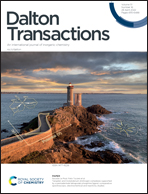Study of the DNA binding mechanism and in vitro activity against cancer cells of iron(iii) and aluminium(iii) kojic acid derivative complexes†
Abstract
Metal ions have unique electrochemical and spectroscopical properties that cannot be attained by purely organic compounds. Most of the metal ions are toxic to humans, but paradoxically, metallodrugs are used in medicine as therapeutics and theranostics. Metallodrugs are eliminated in urine and faeces, and therefore release toxic metals and ligands into aquatic ecosystems, thereby raising concerns regarding environmental risks. The use of metallodrugs based on essential metal ions (i.e., iron, copper and zinc), instead of toxic ions, is a new alternative with minor hazards. Kojic acid is an Asperigillus oryzae metabolite of low toxicity used in the food and cosmetics industries. Its derivatives form stable complexes with iron(III) ions, which bind effectively to DNA and inhibit DNA polymerization. The iron(III)/S2 ligand complexes reduce in vitro colon carcinoma (Caco2) cell viability and significantly decrease the cell number. The kojic acid derivative complexes with iron(III) presented here are an alternative to the currently used platinum complexes in cancer therapy.



 Please wait while we load your content...
Please wait while we load your content...